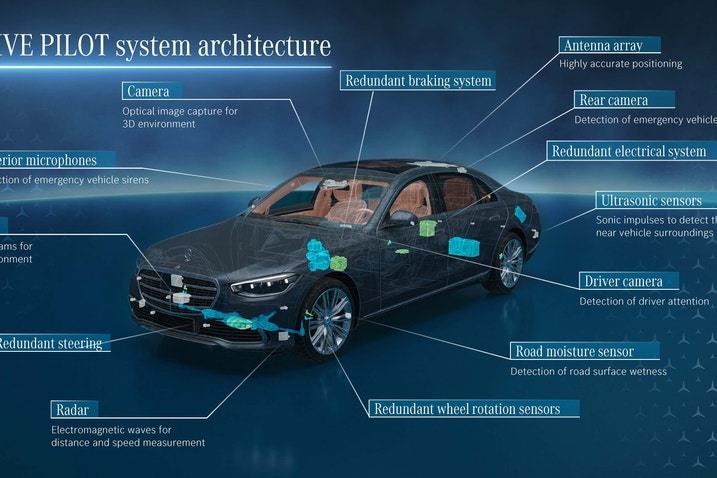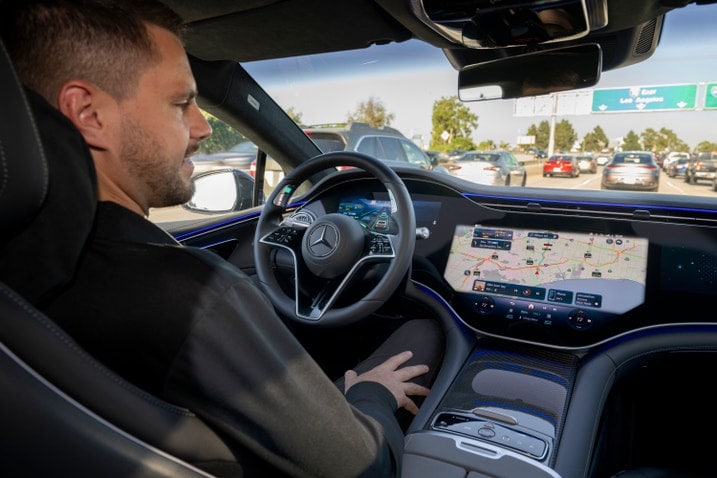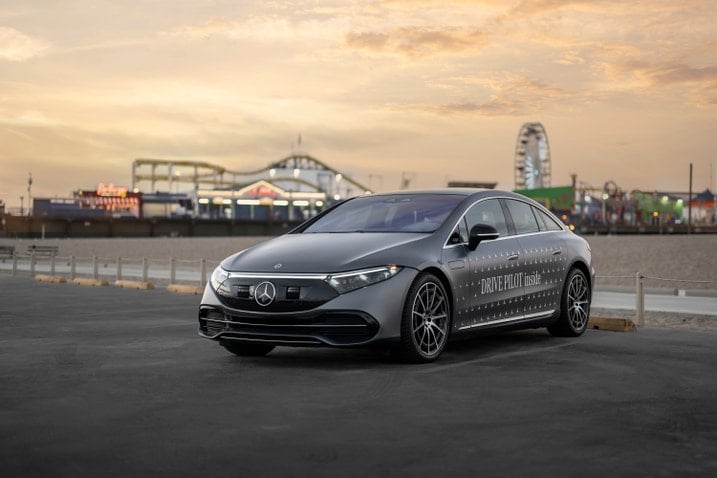- We test the first Level 3 driver assistance system to be approved for consumer use in the U.S.
- Drive Pilot takes over control of the vehicle without requiring the driver to look at the road.
- Limited conditions of operation made it tricky to keep the system activated.
First Drive: Mercedes' Drive Pilot Levels Up Safety (When It's On)
Mercedes' Level 3 system offers a glimpse at a fleeting future
An Edmunds first drive is a great way to introduce you to a new vehicle, but this time what we're driving is taking a back seat to how we're driving. Or I guess, not really driving at all, if things go right. That's because the next big thing from Mercedes-Benz isn't a car: It's a safety system, one that is going to take the first leap for automakers into Level 3 autonomous driving.
Am I Ready for an EV?
- EV ownership works best if you can charge at home (240V outlet) This typically means a 240V home installation, or other places your car is parked for several hours each day. Don't expect a regular household outlet (120V) to suffice.
- Adding a home charging system is estimated to cost $1,616 in This is an estimate for your area. Using your address and the answers you provide, Treehouse can provide a more accurate price.
- Edmunds is partnering with Treehouse, an independent provider of home EV installation services. Learn more Edmunds customers receive a 10% installation discount and 4% smart charger discount. Discount excludes permit, hosted inspection, and load management devices. Valid for 30 days.
Need a refresher on the levels? We've got you covered. But the gist of it is that Level 1 systems allow one advanced safety system to operate at a time (be it adaptive cruise control or lane keeping assistance), while Level 2 incorporates numerous safety systems working in concert. Level 3 marks a huge leap forward, where the car handles the driving task in certain conditions (we'll cover those later) and doesn't expect the driver to be paying attention to the road closely. And there's also the huge distinction of liability. Under a Level 2 system, any crashes that happen are your fault. But with Drive Pilot, if the system is on and an accident occurs, Mercedes is on the hook.
Explain this Drive Pilot thing to me
In order to make the jump from Level 2 to Level 3, Mercedes determined there needed to be a significant jump in terms of computing power, programming, and the number of sensors required. As the graphic above shows, there are big hardware changes required, including the addition of lidar, a rear-facing camera, water sensors in the wheelwells, more precise GPS, and redundant braking/steering systems.
Our weapon of choice for this test is the Mercedes-Benz EQS, which is one of two vehicles (along with the S-Class) that will offer Drive Pilot when it debuts later this year. Adding the equipment to enable Drive Pilot will be a no-cost factory option and Mercedes tells us that if you opt for an EQS or S-Class without the extra hardware, there's no way to retrofit the vehicle. So we'd suggest checking this box even if you're unsure about the system.
Drive Pilot will require an active subscription (turned on through the infotainment system) to work. And it's not cheap: $2,500 per year to begin with, though Mercedes says it will eventually offer multi-year subscriptions to defray some cost over longer periods.
Oh and for now, the system will only be offered in California and Nevada. Mercedes tested the system on roads in both states and those are the only two states to have certified the system for use on public roads. All of the other states have to be handled on an individual basis and Mercedes hasn't indicated which states might be next.
When does Drive Pilot work?
This is the system's biggest limitation. The list of conditions needed for the system to work is extensive, to turn on Drive Pilot the following must all be met:
- Traveling on a divided, mapped highway
- Speed under 40 mph
- A vehicle in front of you at a close distance
- Clear lane markings
- No rain or dust (makes the lidar go wonky)
- Daytime only
- No emergency vehicles in the area
- Driver in the driver's seat, with face visible
So the system won't work at night, won't work when it's wet, and won't work at highway speeds. It also won't change lanes for you; Mercedes' Level 2 system offers automatic, hands-free lane changes, but Drive Pilot does not. And the driver's seat can't be leaned back like you're taking a nap.
It's best to think of this system as only working in heavy traffic, where your speeds remain below 40 mph and you don't need to change lanes because everyone is strapped in for the long haul.
What is it like being driven by Drive Pilot?
Once we found enough traffic to activate the system, it worked pretty much as advertised. Drive Pilot has been live in Germany for about a year now, and Mercedes engineers told us that so far on those highways, there have been no reported accidents involving Drive Pilot.
After handing over control to the system via one of two buttons on the steering wheel, turquoise lights illuminate to let you know the system has taken control of the vehicle. That frees up the driver to engage in what Mercedes calls "secondary activities" using the vehicle screen, which is equipped with apps including a web browser, YouTube and games. The goal of the system is to give you back commute time and allow you to multi-task in other ways.
While Drive Pilot was engaged, it didn't do anything out of the ordinary. The lane centering component seemed spot-on and the acceleration and braking were smooth as well. The biggest change was getting used to not looking back at the road every few seconds to prevent the car from beeping at you like other Level 2 hands-free systems are wont to do. In our roughly one hour behind the wheel, I developed more confidence in the system's ability to drive than I anticipated.
You do still have to keep your head roughly behind the steering wheel, so you can't lean all the way over in front of the screen to see things. Mercedes says that this is to make sure if something happens you can retake control.
On our drive, we did pass some emergency vehicles that had closed the right lane for cleaning. Once the system detected the flashing yellow lights, it prompted me to retake control of the vehicle. When prompted, the driver has 10 seconds to resume control or the system assumes you've had a medical episode, so it will slow the car to a stop, turn on the hazard lights, unlock the doors, and alert emergency personnel. Don't do this.
What's the catch with Drive Pilot?
The system works pretty great; the rub is getting it to turn on and stay on. You might think that traffic-heavy Los Angeles is the perfect place to test this system, but we had to go hunting for traffic thick enough to keep the system on for sustained periods. Its operating conditions only make it work in heavy traffic, where the speeds stay low enough. While trying to test out the games or YouTube videos, we'd often be interrupted because the car in front of us would leave the lane or the speed would just tip above 40 mph.
And in those instances, when you retake control of the vehicle it shuts off all of the active advanced driving systems. So you have to reactivate the Level 2 system, then wait for the prompts for Drive Pilot readiness, then activate the system. Each and every time.
If I were in a commute that wasn't bumper-to-bumper the whole way, I'd be inclined to just keep Mercedes' excellent Level 2 system on the whole time than deal with reactivating Drive Pilot frequently and having to interrupt whatever activity I'd just started on the main screen.
And then there's the elephant in the room: your phone. State laws vary on phone usage, but here in California it seems that you still won't be allowed to use your phone with Drive Pilot active. Mercedes, along with other automakers, is working on a system of turquoise lighting outside the vehicle that can signal it's driving itself. This might one day lead to a world where a driver can legally use his or her phone when the system is active, but those regulations are still being worked out.
Drive Pilot verdict
I had zero problems with the system itself. It works exactly as advertised, and having the freedom to use that gorgeous EQS Hyperscreen from the behind the wheel was pretty cool. But if I was paying that much to have the system, I'd want to make sure I actually get to use it enough to make it worth it. If it's constantly deactivating, my gut feeling is it wouldn't get used as much, if at all.
Mercedes is working on raising the top speed of Drive Pilot; in Germany, the operational speed limit should rise to around 60 mph sometime next year. A change like that here in the U.S. would dramatically expand the system's usefulness, as it would work in moderate traffic situations as well. But there are no promises from the automaker on when that might be coming here.
It's clear that the jump from Level 2 to Level 3 took serious work to improve nearly all of the vehicle's safety systems. And it lays a solid groundwork for Mercedes to build on in the future. But in the present, the full benefits of Level 3 autonomy are not yet realized in this first version of Drive Pilot.
Edmunds says
Mercedes' Drive Pilot system is a great technological achievement, introducing Level 3 driving for the first time to car buyers. But the system's limited range of operating conditions means that it only works in heavy traffic, and the constant interruptions limit its usefulness in day-to-day driving.








 by
by